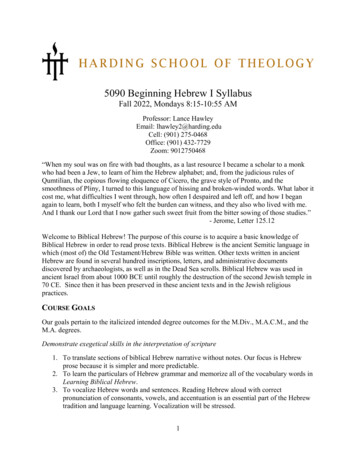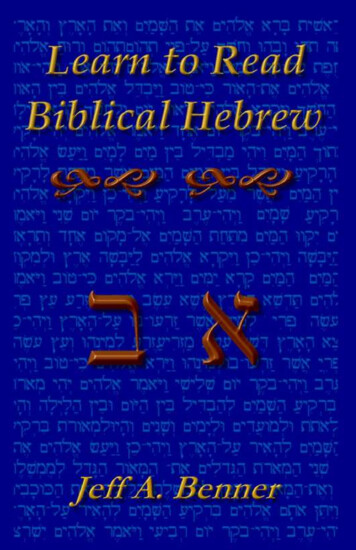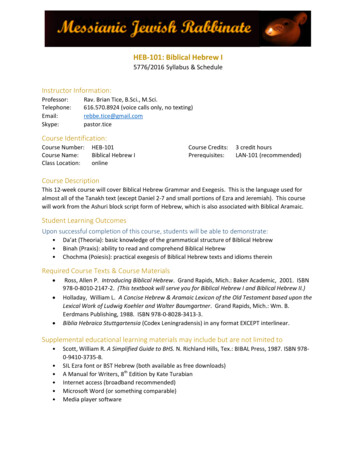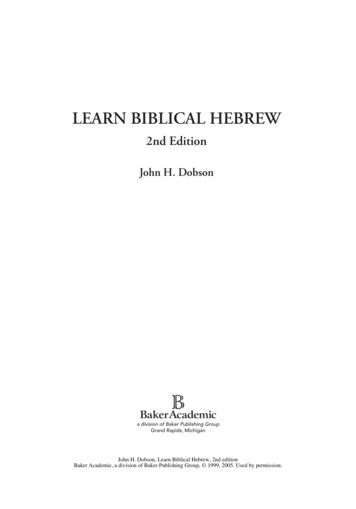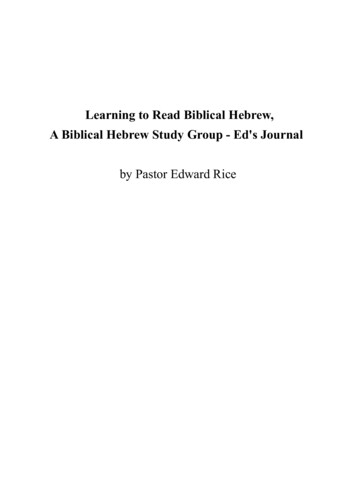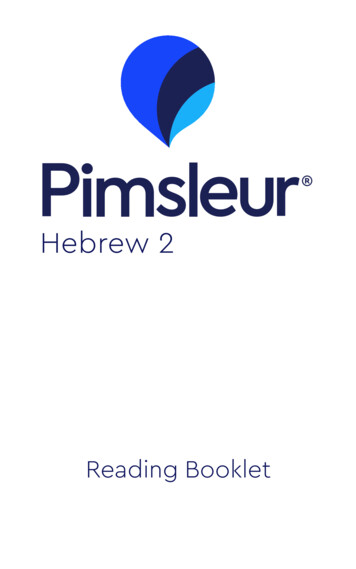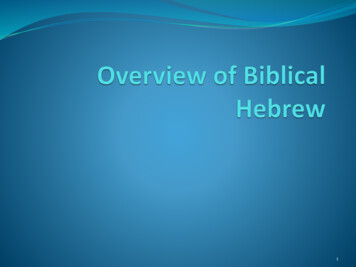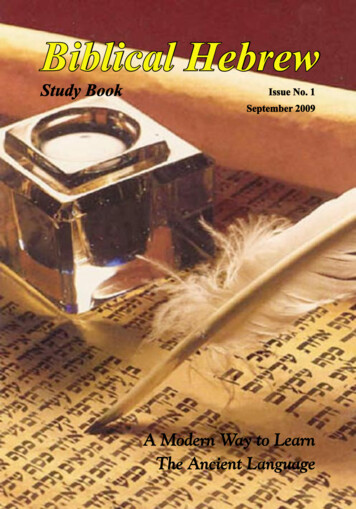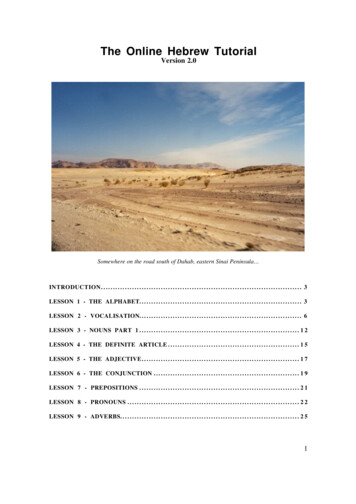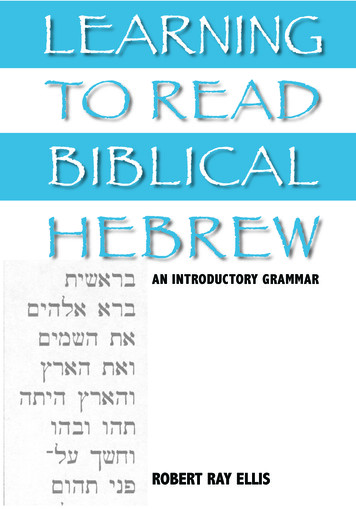
Transcription
LEARNINGTO READBIBLICALHEBREWAN INTRODUCTORY GRAMMARROBERT RAY ELLIS
Learning to Read Biblical Hebrew
Learning to Read Biblical Hebrew:An Introductory GrammarRobert Ray EllisBaylor University PressWaco, Texas USA
2006 by Baylor University PressWaco, Texas 76798All Rights Reserved. No part of this publication may be reproduced, stored in a retrievalsystem, or transmitted, in any form or by any means, electronic, mechanical,photocopying, recording or otherwise, without the prior permission in writing of BaylorUniversity Press.Cover Design by Joan OsthThe BibleWorks Version 3.5 Hebrew font BWHEBB was used in the production of thisgrammar. The font was adapted by means of the addition of a generic Hebrew accent,boxes that indicate unspecified consonants, and dashes that indicate words of unspecifiedlength. The author is grateful to BibleWorks for permission to use the font. BWHEBB,BWHEBL [Hebrew]; BWGRKL, BWGRKN, and BWGRKI [Greek] Postscript Type 1and TrueTypeT fonts Copyright 1994-2002 BibleWorks, LLC. All rights reserved.These Biblical Greek and Hebrew fonts are used with permission and are fromBibleWorks, software for Biblical exegesis and research. Anyone distributing any derivedpublications must comply with displaying and preserving the copyright for the font.Hebrew transliteration fonts used by permission of SIL International, with approvedadaptations.Ellis, Robert Ray.Learning to read biblical Hebrew : an introductory grammar / Robert Ray Ellis.p. cm.Includes index.ISBN-13: 978-1-932792-56-0 (casebound : alk. paper)1. Hebrew language--Grammar. 2. Hebrew language--Grammar--Problems, exercises,etc. I. Title.PJ4567.3.E45 2006492.4'82421--dc222006019302Printed in the United States of America on acid-free paper.
Dedicated toTeresa, Katherine, and Laura,who are yliyGI tx;m.fi
Table of ContentsAcknowledgmentsAbbreviations and SymbolsxviixixLesson 11A CONSONANTS1. Introduction2. Consonant chart3. Characteristics of certain consonants4. Writing the forms of the consonants5. Transliteration6. PronunciationEXERCISESLesson 22A VOWELS1. Introduction2. Vowel chart3. Full vowels4. Half vowels5. Placement of vowels with consonants6. Pronunciation of vowels and vowel classes7. TransliterationEXERCISESLesson 31112344569991011121215171821212122222223253A ACCENTING1. Major accent for a word2. Meteg3B SYLLABLES1. Characteristics of syllables2. Open syllables3. Closed syllablesvii
viii Table of Contents3C SIMPLE SHEVA3D QAMES-HATUF3E TRANSLITERATIONEXERCISESLesson 44A MAQQEF4B DAGESH1. Dagesh-lene2. Dagesh-forte3. Distinguishing dagesh-lene and dagesh-forte4. Transliteration4C VOWEL ALTERATIONSEXERCISESLesson 55A NOUNS, VERBS, and SENTENCES1. Nouns2. Verbs3. Sentences5B DEFINITE ARTICLEEXERCISESLesson 66A PREPOSITIONS1. Independent prepositions2. Prefixed prepositions3. Preposition !mi6B CONJUNCTIONS1. Independent conjunctions2. Vav conjunction6C WEAK CONSONANTSEXERCISESLesson 77A NOUNS1. Absolute and construct 4949525353535556606060
Table of Contents ix2. Inflection of nouns3. Function of nounsEXERCISESLesson 88A ADJECTIVES1. Inflection of adjectives2. Function of adjectives3. Degrees of Comparison8B SIGN OF THE OBJECTEXERCISESLesson 99A PRONOMINAL SUFFIXES ON NOUNS1. Introduction2. Pronominal suffixes for singular nouns3. Pronominal suffixes for plural nouns4. More nouns with pronominal suffixesEXERCISESLesson 1010A PREPOSITIONS WITH PRONOMINAL SUFFIXES1. Prepositions with the forms of the pronominal suffixesused with singular nouns2. Prepositions with the forms of the pronominal suffixesused with plural nounsEXERCISESLesson 1111A PERSONAL PRONOUNS11B SIGN OF THE OBJECT WITH PRONOMINAL SUFFIXES11C DEMONSTRATIVE ADJECTIVES11D RELATIVE 9393939596100100101104107108112
x Table of ContentsLesson 1212A VERBS IN GENERAL1. Verb roots2. Strong and weak verbs3. Moods and tenses4. Stems12B PERFECT CONJUGATION OF THE VERB1. Meaning of perfect verbs2. Perfect verb suffixes12C PERFECT CONJUGATION IN THE QAL STEMEXERCISESLesson 1313A PERFECT CONJUGATION IN THE OTHER MAJOR STEMS1. Introduction2. Perfect conjugation in the nifal stem3. Perfect conjugation in the piel stem4. Perfect conjugation in the pual stem5. Perfect conjugation in the hifil stem6. Perfect conjugation in the hofal stem7. Perfect conjugation in the hitpael stem13B SUMMARY OF THE PERFECT CONJUGATIONEXERCISESLesson 1414A IMPERFECT CONJUGATION OF THE VERB1. Meaning of imperfect verbs2. Imperfect verb prefixes and suffixes14B IMPERFECT CONJUGATION IN THE QAL STEM14C ANALYSIS OF THE VERBEXERCISESLesson 1515A IMPERFECT CONJUGATION IN THE OTHER MAJOR STEMS1. Introduction2. Imperfect conjugation in the nifal 25126127128129132136136136136138140142146146146146
Table of Contents xi3. Imperfect conjugation in the piel stem4. Imperfect conjugation in the pual stem5. Imperfect conjugation in the hifal stem6. Imperfect conjugation in the hofal stem7. Imperfect conjugation in the hitpael stem15B SUMMARY OF THE IMPERFECT CONJUGATIONEXERCISESLesson 1616A VAV WITH PERFECT AND IMPERFECT VERBS1. Introduction2. Vav consecutive with perfect verbs3. Vav consecutive with imperfect verbs4. Analysis of verbs with vav consecutives16B ORIENTATION TO THE HEBREW BIBLE AND LEXICON1. The Hebrew Bible2. Hebrew lexiconsEXERCISESLesson 1717A JUSSIVE AND COHORTATIVE1. Introduction2. Jussive3. Cohortative17B THE IMPERATIVE CONJUGATION OF THE VERB1. Introduction2. Regular imperative conjugation in the major stems3. Long form of the imperative17C VERBS OF PROHIBITION17D ANALYSIS OF VOLITIONAL VERB FORMSEXERCISESLesson 1818A INFINITIVE1. Introduction2. Infinitive 86186186
xii Table of Contents3. Infinitive absolute4. Summary of the infinitive construct and absolute18B PARTICIPLE1. Introduction2. Participle conjugation in the major stems3. Function of the participle18C ANALYSIS OF INFINITIVES AND PARTICIPLESEXERCISESLesson 1919A PRONOMINAL SUFFIXES ON FINITE VERBS1. Introduction2. Pronominal suffixes on perfect verbs3. Pronominal suffixes on imperfect and imperative verbs19B PRONOMINAL SUFFIXES ON NON-FINITE VERBS1. Pronominal suffixes on infinitive constructs2. Pronominal suffixes on participlesEXERCISESLesson 2020A CONNOTATIONS OF VERB TENSES AND STEMS1. Connotations of verb tenses2. Connotations of verb stemsEXERCISESLesson 2121A STATIVE VERBS21B INTRODUCTION TO WEAK VERBS1. Classification of weak verbs2. Disappearance of consonantsEXERCISESLesson 2222A WEAK VERBS: PE-GUTTURAL, PE-ALEF, AYIN-GUTTURAL,AND LAMED-GUTTURAL1. 45245
Table of Contents xiii2. Pe-guttural verbs3. Pe-alef verbs4. Ayin-guttural verbs5. Lamed-guttural verbs6. Summary of characteristics of pe-gutturals, pe-alefs,ayin-gutturals, and lamed-gutturals22B PARTICLES OF EXISTENCE AND NONEXISTENCEEXERCISESLesson 2323A WEAK VERB: PE-NUN23B NOUN PATTERNS1. Segolate nouns2. Geminate nouns3. Noun prefixes and suffixes4. Nouns based on weak roots23C HE DIRECTIVEEXERCISESLesson 2424A WEAK VERB: PE-YOD1. True pe-yod verbs2. Pe-yod/vav verbs (pe-yod based on pe-vav)3. Summary of characteristics of pe-yods24B INTERROGATIVE CLAUSES1. Introduction2. He interrogative3. Interrogative pronouns4. Interrogative adverbsEXERCISESLesson 2525A WEAK VERBS: AYIN-VAV, AYIN-YOD, AND DOUBLE-AYIN1. Ayin-vav and ayin-yod verbs2. Double-ayin verbs3. Summary of characterisitics of ayin-vavs, ayin-yods, 88288293296
xiv Table of Contents25B NUMBERSEXERCISES299302Lesson 2630526A WEAK VERBS: LAMED-ALEF AND LAMED-HE1. Lamed-alef verbs2. Lamed-he verbs3. Summary of characteristics of lamed-alefs and lamed-hes26B IDENTIFICATION OF WEAK VERB ROOTSEXERCISESAppendix 1: Grammatical Summary1. Consonants2. Vowels3. Accenting4. Syllables and Transliteration5. Dageshes6. Definite Article7. Prefixed Prepositions8. Vav Conjunction9. Nouns and Adjectives10. Pronominal Suffixes11. Personal Pronouns12. Demonstrative Adjectives13. Verbs in General14. Clues for Strong Verbs15. Weak VerbsAppendix 2: Analysis of Words1. Analysis of Finite Verbs2. Analysis of Non-Finite Verbs3. Analysis of Nouns and Adjectives4. Analysis ChartAppendix 3: Strong and Weak Verb Paradigms1. Strong Verb (lv;m)'2. Strong Stative Verb (dbeK,' vd;q,' 1322323325326326328331332332333333334337338340
Table of Contents xv3. Weak Verb: Pe-Guttural (dm;[,' qz:x)'4. Weak Verb: Pe-Alef (lk;a)'5. Weak Verb: True Pe-Yod (bj;y")6. Weak Verb: Pe-Yod/Vav (Pe-Yod based on Pe-Vav) (bj;y", vr;y")7. Weak Verb: Pe-Nun (lp;n," vg:n)"8. Weak Verb: Ayin-Guttural (rx;B,' rb)9. Weak Verb: Ayin-Vav ( Wq)10. Weak Verb: Ayin-Vav and Ayin-Yod (aAB, yfi, fAB, tWm)11. Weak Verb: Double-Ayin (bbs)12. Weak Verb: Lamed-Guttural (xl;v')13. Weak Verb: Lamed-Alef (ac'm')14. Weak Verb: Lamed-He (hl'G)"15. Weak Verb: Irregular (!t;n," xq;l,' %l;h,' hy"h)'16. Practice Chart for Strong Verb endix 4: Vocabulary368Index383
AcknowledgmentsI am grateful to my family for making this book possible. My parents taught me tolove language, and my father planted the seed for this grammar when he taught Greek tome from the textbook he wrote. My wife and daughters, who are God’s greatest gifts tome, have sacrificially given time for me to work on the project. Teresa unfailingly lovesand encourages me with her deep wisdom. Katherine and Laura inspire me with their joyfor life and goodness.Harry Hunt, my Hebrew teacher and mentor, taught me to love this remarkablelanguage and to cultivate compassionate excellence. Southwestern Baptist TheologicalSeminary provided a sabbatical to begin this project, and then several years later HardinSimmons University and Logsdon School of Theology provided a sabbatical that allowedfor its completion. Many graduate student assistants have painstakingly helped with thisgrammar through the years – most recently, Jason Patrick, Nathan Maxwell, MeredithStone, Cory Murman, Walt Henson, and Amanda Cutbirth. Finally, I am grateful to allmy students who year by year teach and inspire me with their hunger to read the ancientsacred words of the Hebrew Bible.dAbK' !Te m.vil.-yKi Wnl' al{ hw"hy Wnl' al{Psalm 115:1xvii
Abbreviationsand articleNNFPNFSnifNMPnounnoun, feminine, pluralnoun, feminine, singularnifalnoun, masculine, pluralBDBBHScohortconjCsdem adjDuEngFFPFSG/NhifhithofimpfBrown, Driver, and BriggsNMSPpartpassperfP/G/NpreppronPSSVvav conjvav consnoun, masculine, singularpluralparticiplepassiveperfectperson, gender, and numberprepositionpronounpronominal suffixsingularverbvav conjunctionvav consecutive1CP1CSfirst, common, pluralfirst, common, jussivemasculine2FP2FS2MP2MS3CP3FP3FS3MP3MSsecond, feminine, pluralsecond, feminine, singularsecond, masculine, pluralsecond, masculine, singularthird, common, pluralthird, feminine, pluralthird, feminine, singularthird, masculine, pluralthird, masculine, singularBiblia Hebraica trative adjectivedualEnglishfemininefeminine, pluralfeminine, singulargender and numberhifilhitpaelhofalimperfectMasora magnamasculine, pluralMasora parvamasculine, singularMasoretic textxix
xx Abbreviations and Symbols 9 35687987/2 Indicates that an example followsIndicates that a special note followsStands between Hebrew words that are not syntactically connectedIndicates that a Hebrew verb root followsStands for an unspecified Hebrew consonantStands for an unspecified Hebrew imperfect verb prefixStands for an unspecified Hebrew suffixStands for a Hebrew word of unspecified lengthStands for the end of a Hebrew word of unspecified lengthMarks division between syllables in transliterationMajor accent on a Hebrew word (placed above a consonant)Major accent in transliteration (placed above a vowel)
Lesson 1CONSONANTS1A CONSONANTS1. Introductiona. The only true letters in the Hebrew alphabet are consonants. In biblical Hebrewvowels are indicated by a system of markings, called “pointings,” which appear inconnection with consonants. Vowel pointings will be discussed in the next lesson.b. In Hebrew the consonants which form words, and the words which formsentences, are read from right to left, instead of left to right as in English. In thehistory of writing the Hebrew language various scripts have been used. ThisGrammar employs the square script that appears in contemporary Hebrew Bibles.c. On the following page is a chart which presents the consonants of the Hebrewalphabet, giving their names, forms, transliteration (or phonetic value), andpronunciation.(1) The names of the consonants – like other grammatical terms throughout thisGrammar – are written in English with simplified spellings to make themeasier for beginning students to remember. The names of the consonants inHebrew appear in Appendix 1, section 1.(2) The following consonant chart provides a pronunciation system based onmodern Hebrew. Traditional or classical pronunciation is also indicated whereit varies from modern Hebrew.1
2 Lesson 1: Consonants2. Consonant chartNameFormAlef [Aleph]1aBbGgDdhwzxjyKk 3lm n!s[Pp@c#qrfvTtBetGimelDaletHeVav [Waw]ZayinHetTetYodKaf [Kaph]LamedMemNunSamekAyinPeSadeQof [Qoph]ReshSinShinTav [Taw]PronunciationTransliterationModern'{silent}Bb [bh, v]b as in boyv as in vineGg [gh]g as in girlg as in girlg as in legDd [dh]d as in doord as in doorth as in thinhh as in hatj [w]v as in vine2zz as in zealx [ch]ch as in BachXt as in timey2y as in yesJKk [kh]k as in kingch as in Bachll as in letmm as in metnn as in netss as in setv{silent}Pp [ph, f]p as in petf as in functs as in netsq [ki]k as in kingrr as in richWs as in setH [sh]sh as in shoeTt [th]t as in timeTraditional1Brackets indicate alternatives that may be found in other Hebrew resources.2The pronunciation of3When two forms appear on a line, the second is a “final form.”w as in wellt as in cutk as in barkt as in timeth as in thinw and y may vary when combined with vowels. See the next lesson.
Lesson 1: Consonants 33. Characteristics of certain consonantsa. Final formsMost consonants have the same form whether they appear at the beginning,middle, or end of a word. However, five consonants – kaf, mem, nun, pe, and sade– have different forms, depending upon where the consonant appears in a word.For these five consonants the “medial forms” ofk, m, n, p and c are usedwhen the consonants appear at the beginning or in the middle of a word. The“final forms” of , , !, @, and # are used if the consonant appears at the endof a word. The following words illustrate the use of the medial and final forms. wmk (“like you”) has medial and final kafs and a medial mem. km (“from you”) has medial and final mems and a medial kaf.!tn (“give”) has medial and final nuns.@rc (“refine”) has a medial sade and a final pe.#rp (“break through”) has a medial pe and a final sade.b. Begadkefat consonantsB, G, D, K, P, and T may appear with a dot in thecenter (as just written), or without the dot as b, g, d, k, p, and t. The dot(1) The six consonantsis a dagesh-lene whose nature will be discussed later. A popular mnemonicdevice for remembering these six consonants is begadkefat, which employsthe first letter in the name of each consonant.(2) Two of the begadkefat consonants also have final forms: kaf and pe. The final and @ cannot take the dot which is a dagesh-lene.c. Guttural consonantsFour consonants are known as gutturals, since originally they werepronounced primarily in the throat. They are a, h, x, and [. As gutturals theyhave some unique features which will be discussed in future lessons. Theconsonant r sometimes acts in the same manner as a guttural.d. Labial consonantsThree consonants are known as labials, since they are pronounced primarilywith the lips. They are B, m, and P.e. Quiescent consonants(1)a, h, w, and y are called quiescent consonants because they sometimes quiesce
4 Lesson 1: Consonantsor become silent, losing their consonantal properties. For example, whileconsonants at the beginning or in the middle of a word normally havevowel pointings, in some situations the quiescents lose their ability toreceive a vowel. This and other characteristics of quiescents will bediscussed in future lessons.h appears at the end of a word it can have a dot, called amappiq (qyPim; “pronounced”), which strengthens the h so that it retains(2) Whenits consonantal character rather than quiescing. Hl' (“to her”) has a mappiq in the h, which means it does not quiesce.f. Sibilant consonantsFive consonants are known as sibilants because their pronunciation involves an ssound. They are z, s, c, f and v.4. Writing the forms of the consonantsa. When learning the write the forms of the consonants, the student must take care todistinguish between certain forms which might easily be confused with oneanother. Note the distinctions in the following pairs.(1)(2)(3)(4)(5)bgbkgndzd dr(7) h x(8) x t(9) w z(10) w y(6)(11)(12)(13)(14)(15)w!wrjmkn !(16)(17)(18)(19)(20)m ms s[cfv5. Transliterationa. Knowing the transliteration of Hebrew has several advantages. It allows one tocomprehend Hebrew that is written only in transliterated form. It also permits theeasy comparison of transliterated Hebrew with transliterated words from otherSemitic languages (that is, other ancient-Near-Eastern languages in the samefamily as Hebrew). For the beginning student transliteration can be an aid inlearning the correct pronunciation of words; however, the student must come tothe point of being able to pronounce Hebrew without the help of transliteration.b. While Hebrew is read from right to left, transliteration is read from left to right (inthe normal English manner), as the following examples illustrate. These Hebrew
Lesson 1: Consonants 5words are spelled with consonants only. Transliterations appear to the right, aswell as translations in )(13)(14)(15)lka GhdfrbD lhtxTvpnbwj!hKrwslpnabc wTdgB ��beneath”)(21)npH(“living 24)sjr(“turn ��face”)(30)lwdGhf[mdsx@lavgn!jqbhz rD work”)xsd(“steadfast t”)xC lc(“withdraw”)'nky(“I”)Ksp(“silver”)cC dyq(“righteous”)PlHty(“Philistine”)mzBx (“altar”)6. Pronunciationa. Some Hebrew consonants have sounds which are very difficult for Englishspeaking persons to reproduce. Thea and [ are glottal stops (producing gutturalsounds) that are especially challenging. They may be imitated by a slight stoppingof the breath. However, for the sake of simplicity they are treated in this Grammaras if they are silent letters.b. Theoretically, the begadkefat consonants have harder or sharper sounds when thedot or dagesh-lene is present, and softer or duller sounds when the dagesh-lene isabsent. However, this softening of the begadkefats when they lack the dageshlene actually occurs with only three of these consonants in modern Hebrewpronunciation. These three are bet, kaf, and pe:BKP b (as in boy) k (as in king) p (as in pet)bkp v (as in vine) ch (as in Bach) f (as in fun)
6 Lesson 1: ExercisesThe presence or absence of the dagesh-lene does not change the pronunciation ofthe other three begadkefat consonants:G or gD or dT or t g (as in girl) d (as in door) t (as in time)c. The pronunciation of x and k involve a hard ch sound which is spoken low in thethroat, like the German ch, as in Bach.d. The pronunciation of c involves the eliding of two consonantal sounds: t followedimmediately by s, as in the word nets.Lesson 1: EXERCISESa. Repeatedly write and pronounce the Hebrew consonants until their forms andsounds become familiar.b. Section 1A.4 lists pairs of consonants that might easily be confused with oneanother. Write each pair three times, making sure to form the letters distinctly.While writing them, note how the pairs of letters may be distinguished from oneanother through such features as curved or pointed corners, or the presence orabsence of “tittles” (or “tabs”).c. Reproduce from memory the consonant chart in section 1A.2, with the exceptionof the traditional pronunciation and items in brackets.d. From memory list the consonants in the following categories.(1) Gutturals(3) Quiescents(2) Labials(4) Sibilantse. Practice transliterating the Hebrew words in section 1A.5b. While doing thisexercise, cover the transliterations that appear beside the words. When finishedcheck the work against the answers in the book.f. The following words from the Hebrew Bible are written with consonants only; thespelling of some is modified to make them appropriate for this lesson. Rewrite thewords in Hebrew and then transliterate them, noting their resemblance to familiarbiblical names or terms. A scripture reference for each word appears inparentheses.
Lesson 1: Exercises 5)(16)(17)(18)(19)(20) yhlahwhyxrT rba1yrfjwlqdcyKlmrghla[mvy hrbahrfqxcy lmybahqbr!w[dG!tnrTsaykDrm!mhlaynD(Ge 1:1)(21)(Ge 2:4)(22)(Ge 11:24)(23)(Ge 11:26)(24)(Ge 12:5)(25)(Ge 12:5)(26)(Ge 14:18)(27)(Ge 16:1)(28)(Ge 16:11)(29)(Ge 17:5)(30)(Ge 17:15)(31)(Ge 17:19)(32)(Ge 20:2)(33)(Ge 22:23)(34)(Jdg 6:11)(35)(2Sa 5:14)(36)(Est 2:7)(37)(Est 2:7)(38)(Est 3:1)(39)(Da wnbl kvlatyB!wrbxwDdgm yzrG lvwrytBbv yprf wlv(Ezr 2:2)(Ge 45:10)(Ex 19:1)(Jos 5:12)(1Sa 13:19)(1Sa 13:19)(Nu 26:3)(Dt 1:7)(Dt 1:7)(Dt 1:7)(Dt 3:25)(Ge 12:6)(Ge 12:8)(Ge 13:18)(Jos 12:21)(Jdg 9:7)(2Sa 5:5)(Ex 20:8)(Isa 6:2)(Nu 6:26)g. Find in a Hebrew Bible words (21) to (40) from the preceding exercise. Note thatfrom the perspective of English-speaking persons, the Hebrew Bible is read fromback to front. If one is using the Biblia Hebraica Stuttgartensia (BHS) – thestandard edition for academic purposes, a table of contents appears at the end ofthe prolegomena (after page LV). Although this table employs Latin and Hebrewterms, most of the names of biblical books can be easily deciphered. Whilefinding the words listed above in BHS, ignore for now the markings around the1Note that in this word and several others a yod or vav sometimes seems to represent a vowel ratherthan a consonant (with yod e or i and vav o or u). The following lesson will explain how these twoconsonants sometimes function to represent vowels. In this exercise simply give their consonantaltransliteration.2Notice that the traditional English transliteration of Hebrew names sometimes renders athan y. Use the technically correct y for the purposes of this exercise.y as j rather
8 Lesson 1: Exercisesconsonants (most of which are vowel pointings). Also note that BHS occasionallyalters the spelling of the words, sometimes adding prefixed letters or omittingdoubled consonants. The significance of these differences will be explained infuture lessons.h. Sometimes poetic texts in the Hebrew Bible employ an acrostic as a literarydevice, with the result that successive stichs (or lines) of poetry begin withsuccessive consonants of the Hebrew alphabet.(1) Notice the use of an acrostic in Psalm 34 by looking in a Hebrew Bible. InBHS the pattern is emphasized by listing the successive letters of the Hebrewalphabet in the margin. Observe that the Psalm 34 acrostic does not haveseparate lines for sin and shin, a typical feature of Hebrew acrostics (since thetwo letters would appear the same in an unpointed [pre-Masoretic] text).Besides the sin and shin, one other letter is missing from the acrostic in Psalm34. Identify which consonant is missing.(2) Find at least one other Psalm which employs an acrostic and observe whetheror not the consonantal pattern is complete.
Lesson 2VOWELS2A VOWELS1. Introductiona. Originally biblical Hebrew was written only with consonants; no vowels appearedin the text. When reading one had to supply the vowels from one’s knowledge ofthe language. Later in the development of Hebrew a few of the consonants wereused to indicate the presence of certain vowels. Around AD 500-1000 a group ofJewish scholars called Masoretes (from massorah [hr'ASm;] “tradition”)introduced an ingenious system for indicating all of the vowels in the HebrewBible. Their system designates vowels by means of pointings or marks (mostlydots and dashes) which are placed around the consonants in such a way that theconsonantal text itself is not altered. The resulting pointed Hebrew Bible is knownas the Masoretic text (MT).b. The chart on the following page groups Hebrew vowels in two broadclassifications: full vowels and half vowels. Full vowels are further divided intothree subgroups: short, long and naturally-long. Half vowels are divided into twosubgroups: simple sheva and composite shevas.c. The chart also presents the name,1 form, transliteration, and approximatepronunciation of each vowel. The location of the vowels in relation to consonantsis indicated by use of the symbol 3 which stands for a consonant.1The names of the consonants in Hebrew appear in Appendix 1, section 1.9
10 Lesson 2: Vowels2. Vowel charta. Full Vowels(1) aa as in fatheree as in bedii as in machinei as in hitoo as in rowo as in topuu as in ruleu as in nutAa as in fatherEe as in bedIOo as in rowa as in had(2) Long3'3e3oQamesSereHoleme as in they(3) Naturally-longSere-yodHireq-yodHolem-vav [-waw]Shureq1y3ey3iA3W3e as in theyÓi as in machineÙo as in row u as in rule3.e2e as in below33]3/3\·a as in fatherÈfle as in bedÛo as in rowb. Half vowels(1) Simple shevaSheva [Shewa](2) Composite shevasHatef-patahHatef-segolHatef-qames1The brackets indicate alternative spellings.2Note that the transliteration for each of the half vowels is a superscript letter.3A simple sheva is not always pronounced. See Lesson 3C.a as in hado as in top
Lesson 2: Vowels 113. Full vowelsa. The classification of full vowels in the preceding chart as short, long, andnaturally-long is more useful for grammatical purposes than for the sake ofpronunciation. These distinctions in vowel length are usually not expressed in thepronunciation of contemporary Hebrew – a matter that is discussed later. (Seesection 3.6,a.)b. Naturally-long vowels(1) It was mentioned previously that even before the Masoretes introduced theirsystem of vowel pointings some consonants – namely, the quiescents – couldserve as “vowel letters,” indicating the presence of a vowel in the Hebrewtext.1 When these consonants represented vowels, the Masoretes simplycreated special vowel forms which were the combination of the consonantsand particular vowel pointings or dots.2(2) Two of the quiescents,w and y, occur frequently as vowel forms. They aretreated in this Grammar as “naturally-long vowels,” so termed because theyare long vowels that are naturally represented in the consonantal text. Thevowel forms which combinew and ywith certain short vowels and otherpointings are as follows.Yod sere Yod hireq Vav holem Vav a dot )c. Qames and qames-hatufQames, a long vowel, and qames-hatuf, a short vowel, are represented by thesame symbol:3'.The way to determine which vowel is intended by thissymbol will be discussed in Lesson 3D.1The classical term used for the quiescents when they represent vowels is matres lectionis, whichmeans “mothers of reading.”2yh in a situation where the yodTo illustrate the Masoretes’ approach, if the consonantal text hadrepresented a long i vowel, the Masoretes simply added a hireq before the yod to indicate the long vowel byimeans of the combination of the hireq and the yod. The result would be yh.3y3, (segol-yod) sometimes serves as the naturally-long “e” vowel instead of sere-yod.
12 Lesson 2: Vowels4. Half Vowelsa. The English language has nothing equivalent to the half vowels (the simple shevaand the composite shevas). They are unique in that, as their name suggests, theyare weaker than full vowels. This weakness is obvious in two ways.(1) Half vowels (along with consonants) cannot serve to form a syllable, whilefull vowels can. (See Lesson 3B.1).(2) In pronunciation the half vowels receive a more abbreviated sound than thefull vowels. This situation is indicated by the names of the composite shevas,for the word hatef means “hurried.” Thus a hatef-patah is a “hurried,” orabbreviated, patah; a hatef-segol is a rapidly spoken segol; and a hatef-qamessounds like an abbreviated qames-hatuf.b. The simple sheva may be either vocalized or silent. When vocalized it usuallysounds like the rapidly spoken e in below. The circumstances in which the simplesheva is vocalized or silent will be discussed in Lesson 3C.c. The composite shevas have the following characteristics.(1) They are always vocalized, never silent.(2) They occur only with the gutturals (a,h, x, and [), which prefer compositeshevas to the simple sheva.(3) They occur only with a guttural that stands at the beginning of a syllable, asthe following words illustrate. In each case the composite sheva occurs at thebeginning of the word and therefore at the beginning of a syllable. yviymix] x·mÓHÓ (“fifth”) yhil{a/ 'ÈlOhÓm (“God”)ynI[ vÛnÓ (“poverty”)5. Placement of vowels with consonantsa. The naturally-long v
learning the correct pronunciation of words; however, the student must come to the point of being able to pronounce Hebrew without the help of transliteration. b. While Hebrew is read from right to left, transliteration is read from left to right (in the normal English manner), as the following examples illustrate. These Hebrew
